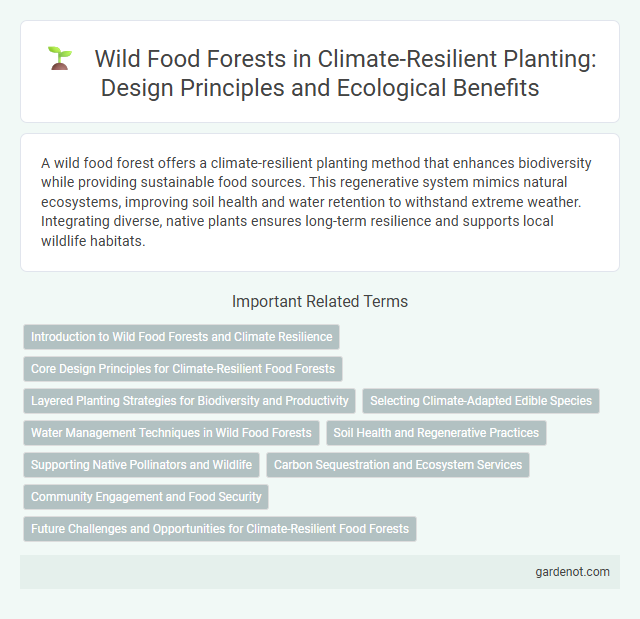A wild food forest offers a climate-resilient planting method that enhances biodiversity while providing sustainable food sources. This regenerative system mimics natural ecosystems, improving soil health and water retention to withstand extreme weather. Integrating diverse, native plants ensures long-term resilience and supports local wildlife habitats.
Introduction to Wild Food Forests and Climate Resilience
Wild food forests are sustainable ecosystems designed to mimic natural forests while providing diverse, nutritious food sources that enhance biodiversity and support climate resilience. These multi-layered systems improve soil health, increase carbon sequestration, and buffer temperature extremes, helping to mitigate climate change impacts. Integrating native plants and perennials, wild food forests promote ecosystem stability and long-term food security in changing environmental conditions.
Core Design Principles for Climate-Resilient Food Forests
Wild food forests emphasize biodiversity, layered vegetation, and native species to enhance climate resilience and ensure sustainable food production. Integrating deep-rooted perennials with seasonal plants improves soil health, promotes water retention, and reduces erosion. Key design principles include mimicking natural ecosystems, prioritizing drought-tolerant species, and fostering symbiotic plant relationships for long-term productivity.
Layered Planting Strategies for Biodiversity and Productivity
Layered planting strategies in wild food forests enhance biodiversity by mimicking natural forest structures, integrating canopy trees, understory shrubs, herbaceous plants, ground covers, and root crops. This vertical complexity promotes ecosystem resilience, improves nutrient cycling, and supports a variety of wildlife habitats, increasing overall productivity. Incorporating nitrogen-fixing plants and dynamic accumulators boosts soil fertility, while diverse crop layers reduce pest pressures and optimize space utilization.
Selecting Climate-Adapted Edible Species
Selecting climate-adapted edible species for a wild food forest enhances resilience against temperature fluctuations and extreme weather. Indigenous fruit trees, nuts, and perennial vegetables with deep root systems improve soil health and water retention, supporting sustained yields. Integrating drought-tolerant and pest-resistant plants promotes biodiversity while ensuring reliable food sources in changing climates.
Water Management Techniques in Wild Food Forests
Water management techniques in wild food forests prioritize rainwater harvesting, mulching, and swale construction to maximize soil moisture retention and reduce erosion. Incorporating native drought-tolerant plants enhances the ecosystem's resilience by optimizing water use efficiency and promoting natural groundwater recharge. These strategies collectively support sustainable water cycles critical for maintaining biodiversity and productivity in climate-resilient food systems.
Soil Health and Regenerative Practices
Wild food forests enhance soil health through diverse plant root systems that improve aeration, increase organic matter, and promote nutrient cycling essential for climate resilience. Regenerative practices such as mulching, minimal soil disturbance, and polycultures bolster microbial activity and soil structure, reducing erosion and enhancing water retention. These methods create a self-sustaining ecosystem that supports biodiversity and long-term productivity amid changing climate conditions.
Supporting Native Pollinators and Wildlife
Wild food forests enhance climate resilience by creating diverse habitats that support native pollinators such as bees, butterflies, and birds, which are essential for ecosystem stability and plant reproduction. These forests provide continuous forage and shelter, promoting biodiversity and strengthening food webs critical to climate adaptation. Integrating native species and maintaining layered vegetation structures optimize habitat connectivity and improve resilience against environmental stresses.
Carbon Sequestration and Ecosystem Services
Wild food forests enhance carbon sequestration by integrating diverse native tree species that efficiently capture and store atmospheric CO2 in biomass and soil. These ecosystems support critical services such as habitat provision, soil stabilization, and water regulation, promoting biodiversity resilience against climate change. Implementing wild food forests contributes to long-term carbon storage while sustaining local food security and ecological balance.
Community Engagement and Food Security
Wild food forests enhance community engagement by involving local stakeholders in sustainable planting, promoting biodiversity, and preserving indigenous knowledge. These forests contribute significantly to food security by providing diverse, nutrient-rich wild foods that are resilient to climate variability and extreme weather. Integrating wild food forests into local landscapes fosters ecological balance while supporting community livelihoods and health.
Future Challenges and Opportunities for Climate-Resilient Food Forests
Wild food forests face future challenges including climate unpredictability, pest invasions, and shifting species ranges, impacting biodiversity and yield stability. Opportunities lie in integrating native drought-resistant species, utilizing agroforestry techniques, and leveraging remote sensing for adaptive management. Enhancing genetic diversity and community-driven stewardship can further strengthen climate resilience and ensure sustainable food production.
Wild food forest Infographic

 gardenot.com
gardenot.com